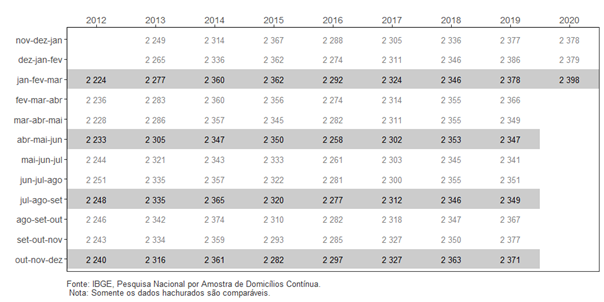Continuous PNAD: unemployment rate hits 12.2% and underutilization rate is 24.4% in the quarter ended March 2020
April 30, 2020 09h00 AM | Last Updated: May 04, 2020 02h16 PM
The unemployment rate (12.2%) in the moving quarter ended March 2020 increased 1.3 percentage points in comparison with that of the quarter October-December 2019 (11.0%) and fell by -0,5 percentage points against the same quarter a year ago (12.7%).
| Indicator/Period | Jan-Feb-Mar 2020 | Oct-Nov-Dec 2019 | Jan-Feb-Mar 2019 |
|---|---|---|---|
| Unemployment rate | 12.2% | 11.0% | 12.7% |
| Underutilization rate | 24.4% | 23.0% | 25.0% |
| Usual real earnings | R$2,398 | R$2,371 | R$2,378 |
| Change of usual earnings in relation to: | 1.1% (stability) | 0.8% (stability) | |
The unemployed population (12.9 million persons) increased by 10.5% (1.2 million persons more) in relation to the previous moving quarter and fell (-4.0%, or by 537 thousand persons) against the same quarter in the previous year.
The employed population (92.2 million) fell by 2.5% versus the previous quarter (a decrease 2.3 million persons) and remained stable in relation to the same quarter in 2019.
The informality rate reached 39.9% of the employed population, amounting to a total 36.8 million informal workers. In the previous moving quarter, the rate was 41.0% and in the same quarter a year ago, 40.8%.
The population out of the workforce (67.3 million persons) was a record in the series initiated in 2012, with increases of 2.8% (more than 1.8 million persons) against the previous quarter and of 3.1% (2.0 million persons) against the same quarter in 2019.
The compound underutilization rate (24.4%) increased 1.4 p.p. versus the previous moving quarter (23.0%) and fell 0.6 p.p. against the same quarter in 2019 (25.0).
The underutilized population (27.6 million persons) recorded an increase of 5.6% (1.5 million persons more) against the previous moving quarter (26.2 million) and fell -2.5% (by 704 thousand persons) versus the same quarter in 2019 (28.3 million).
The discouraged population (4.8 million) was statistically stable in both comparisons. The percentage of discouraged persons in relation to the population in the workforce or discouraged (4.3%) recorded a positive change of 0,2 p.p. against the previous moving quarter (4.2%) and it remained stable in relation to the same quarter in the previous year.
The number of workers with an employment contract in the private sector (except domestic workers), estimated at 33.1 million, fell -1.7% (572 thousand persons) against the previous moving quarter and remained stable versus the same quarter in 2019.
The number of workers without a formal contract in the private sector (11.0 million persons) fell -7.0% (832 thousand persons) in relation to the previous moving quarter and remained stable compared to the same quarter in 2019.
The number of self-employed workers reached 24.2 million persons, with a decrease of -1.6% (398 mil thousand persons) in comparison with the previous moving quarter and an increase of 1.7% (409 thousand persons) against the same period in 2019.
The average usual real earnings (R$ 2,398) in the moving quarter ended March was stable in both comparisons.
The real usual wage bill (R$ 216.3 billion) recorded a decrease (-1.3% or R$ 2.9 billion) against the previous quarter and was stable versus the same quarter in 2019.
Unemployment rate - Brazil – 2012-2020 (%)

In the groups of activity, against the previous moving quarter, employment fell in six of the ten groups surveyed: Industry (-2.6%), Construction (-6.5%), Trade and Repair of Vehicles (-3.5%), Lodging and feeding (-5.4%), Other services (-4.1%) and Domestic Services (-5.9%), with stability in the other four. Versus the same quarter in 2019, employment increased 3.4% in Public administration, defense, social security, education, human health and social services, with stability in the other groups.
The employment population ratio (percentage of employed persons in the population at working age) was estimated at 53.5%, with a decrease of 1.6 percentage points versus the previous moving quarter (55.1%) and 0.4 percentage points versus the same quarter in 2019 (53.9%).
Workforce (employed and unemployed persons), estimated at 105.1 million persons, fell (-1.0% or a decrease of 1.1 million persons) in relation to the previous moving quarter and remained stable against the same quarter in 2019. The potential worforce (8.3 million persons) increased 7.3% (568 thousand persons more) against the previous moving quarter and remained stable against the same quarter in 2019.
Compound underutilization rate – quarters January to March – 2012 to 2020 – Brazil (%)

The number of time-related underemployed persons (6.5 million) decreased in comparison with the previous moving quarter (-4.8%, or r325 thousand persons) and, also, in relation to the same quarter in 2019 (-4.4% or 301 thousand persons).
The number of employers (4.4 million persons) was stable in both comparisons.
The category persons employed in the public sector (11.7 million persons), which includes military and civil servants, remained stable in comparison with the previous quarter and increased 2.6% (by 290 thousand persons) against the same quarter in 2019.
Average monthly usual earnings from all the jobs of employed persons, in the month of reference – Brazil – 2012/2020 (R$)


